Can You Paint Siding On A House
If you're lucky, all your business firm may need earlier repainting is a adept, healthy bathroom. Wash it down with a hose, and go over stubborn dirt with a scrub castor and warm, soapy water. Or wash it down with a power washer. If you're not so lucky, then you just have to face the fact that a fourth dimension-consuming and dirty job lies ahead of you. Do the task well, and your paint chore will not only wait ameliorate, only it will last for five to 8 years on average.
Start by thoroughly examining the outside of the house or outbuilding -- not merely the outside walls only under the eaves, around windows and doors, and along the foundation. Expect for dissever shingles and siding, popped nails, peeling or blistering paint, mildew, and rust stains. Once you've identified the areas that need attention, coil up your sleeves and make the repairs.
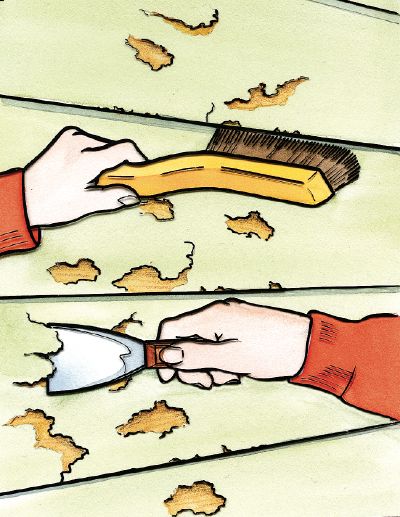
©2006 Publications International, Ltd.
Remove small areas of defective pigment with a wire brush and/or a
wide-blade putty knife. Scrub under the laps of clapboard siding
and on downspouts and gutters.
ScrapingUse a wire brush and a wide-blade putty knife to remove small areas of defective pigment. Scrub nether the laps of clapboard siding as well as on downspouts and gutters. For speedier work on metal, a wire castor zipper on an electrical drill will remove rust and pigment with less attempt. For more extensive paint removal, invest in a sharp pull scraper -- a tool with a replaceable blade that'due south capable of stripping onetime paint all the way down to bare forest with a single scrape. Hold the scraper so the blade is perpendicular to the wood, apply moderate to firm pressure level, and drag it along the surface. Go along the blade flat confronting the forest and so it doesn't gouge the surface.
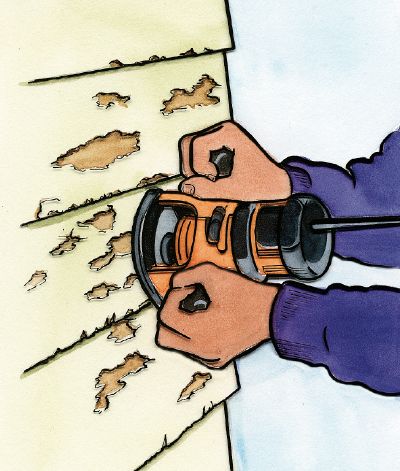
©2006 Publications International, Ltd.
Motion an electric orbital sander upwards and downwardly or back and along to
remove old paint and feather crude edges.
SandingFor smoothing the edges of scraped spots here and at that place, yous can wrap a piece of sandpaper around a wood cake. For larger areas, it'southward less tiring and more effective to use an electric orbital sander. Motility it up and down or back and forth beyond the surface to remove erstwhile paint and smooth rough edges at the same time. Don't use an electrical disc sander or a chugalug sander. Both can go out swirls or dips in the wood that will bear witness through a new coat of paint.
MeltingFor specially heavy deposits of paint, oestrus may be more effective than muscle. 1 fashion to employ rut is with an electric paint remover, which is a device with a platelike heating chemical element that "cooks" the paint and has a born scraper to pull it off. Wearing heavy gloves, hold the heating element against the surface until the paint sizzles. Pull the remover firmly over the surface. The fastened scraper will pull off the cooked paint as you go.
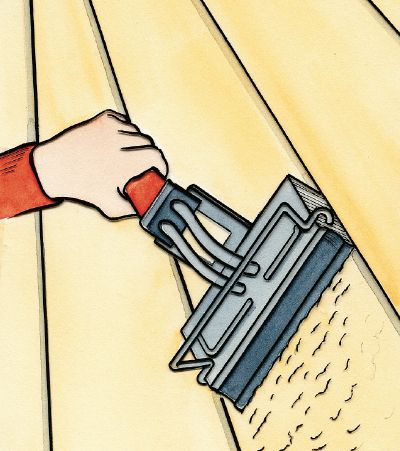
©2006 Publications International, Ltd.
Another style to remove old pigment is with an electric pigment
remover -- a device with a platelike heating chemical element
that softens the pigment and has a built-in scraper.
Liquid Paint RemoversUse liquid paint removers merely as a last resort. They work well, but they're expensive, especially on large jobs. Besides, they can slop onto perfectly good paint, giving you one more trouble to deal with.
PrimingOne time you take removed all the loose paint, you should utilize an appropriate primer to some of the distressed areas, especially if your paint-removal system has exposed raw forest or bare metal. The kind of primer you lot apply depends on the kind of pigment you'll exist using afterwards. For latex paint, use latex primers; for solvent-thinned paints, use solvent-base primers; and for metals, employ metal primers. Non but do these coatings provide extra protection confronting the elements, they also form a firm foundation for finishing paints. As well, priming is always required when yous're working on new wood.
Other Prep WorkFifty-fifty if y'all're fortunate enough to skip spot-scraping, sanding, and repriming, there are still some prepainting chores to attend to. They're much less laborious than removing peeling paint but no less vital to a successful task.
Rust stains on siding, overhangs, and foundations need to exist removed. Leaks in gutters and downspouts take to be repaired. Loose caulking should be replaced, along with split shingles. Cracks in siding must exist filled, sanded, and primed. Mildew must be scrubbed off, and steps should exist taken to eliminate its render.
Also, to make painting easier, storm windows, screens, shutters, awnings, wall-mounted light fixtures (be sure to turn the ability supply off), the mailbox, and even the street address numbers should be taken down, cleaned, and painted separately. You may even want to remove downspouts, as it'southward sometimes hard to become a paintbrush behind them.
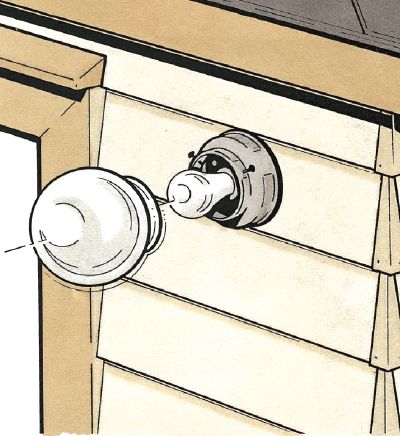
©2006 Publications International, Ltd.
To make painting easier, remove light fixtures and other accessories.
You can typically complete all of these preparations for an unabridged business firm in a single day or over a weekend. If you're painting a porch or an outbuilding, it may just have an hour. If you're painting with latex, you tin start the following day; solvent-base paint does not adhere well to moist surfaces so wait several days until all the washed surfaces are admittedly dry before applying this blazon of paint.
WashingNot only volition this procedure go the outside of your house clean and provide a dirt-free foundation for the new coating, it will likewise aid yous notice surface flaws that have to be dealt with.
Depending on just how dirty the exterior of your house is and on the house's size, there are two means to approach this task. If you live in an average-size house, use a garden hose with a carwash brush attachment to breast-stroke the big areas. For caked-on dirt, apply a scrub castor or a sponge and a pail of warm water with a adept, strong household detergent in it. Work from the elevation downward, and rinse all areas where y'all scrubbed with h2o.
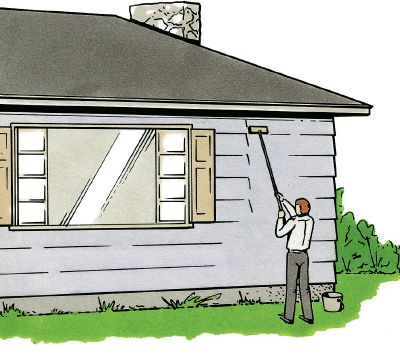
©2006 Publications International, Ltd.
To remove caked-on dirt, use a scrub brush or a sponge and a pail of
warm water with a good, potent household detergent in it. Work from
the top down and rinse all areas where you scrubbed.
For bigger houses or for faster work on smaller ones, rent a high-pressure level spray cleaner. This device attaches to your abode's h2o-supply system and puts out a jet of water at a pressure of about 600 pounds per square inch. It is equipped with a handheld wand tipped with a trigger-activated nozzle. The pressure level is loftier enough to dislodge non only stubborn dirt, mildew, stains, and dried-on sea-spray salt, information technology's enough to remove peeling paint. In fact, if the jet nozzle is held too close to the surface it can fifty-fifty skin off perfectly audio paint, split open shingles, and drill a hole in siding. So follow the manufacturer's directions and wear goggles and protective wearable.
You can utilize the spray cleaner while working from a ladder -- although scaffolding is amend -- but practice at basis level first; the strength of the spray against the house could knock y'all off a ladder if you're not careful. Some of these machines come with separate containers you can fill up with cleaning solutions or anti-mildew solutions. Sprayers are and so powerful that unremarkably you lot probably won't need to utilize a cleaning solution; if you do, remember to rinse the surface with make clean water afterward.
Resetting Popped NailsThe house bathroom may reveal nails that have popped out of the siding or rusting blast heads that have left streaks of rust on exterior walls. If so, use sandpaper or steel wool to make clean the nail heads. On clapboard siding, use a nail set up to recess the nail caput about ⅛ inch below the surface of the wood. Dab on a coat of rust-inhibiting primer (unless the nail is aluminum or nonrusting galvanized steel), and let information technology dry. Then fill the nail hole with spackle or putty. When the filler is dry, give it a coat of primer. For flathead nails, which cannot be recessed, sand the heads until they're shiny, and coat with primer.
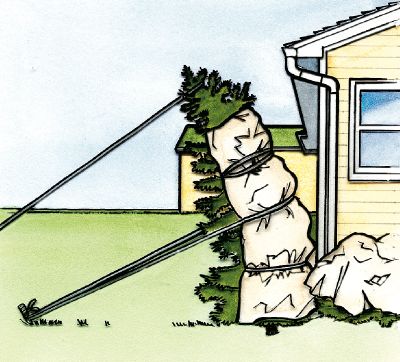
©2006 Publications International, Ltd.
To go on trees out of the way while you're painting, tie a rope around
the torso, and pull the tree out abroad from the house. Stake the
other end of the rope out in the yard.
Roofing ShrubsCopse, bushes, and ornamental shrubs can also get in the mode of your painting. Prune whatsoever branches that hang over the house or castor up against walls. Evergreen trees and alpine bushes growing close to the house can be wrapped with canvas drib cloths. Tie one finish of a rope effectually the trunk at to the lowest degree halfway up. Pull the superlative of the tree out and abroad from the business firm, and tie the other end of the rope to a pale placed farther out in the chiliad. Embrace smaller shrubs, flower beds, sidewalks, and driveways with drop cloths to protect them from paint drips and spills.
Estimating How Much Pigment You'll NeedThe size of the firm, the status of the surfaces, the type of blanket you lot select, and the method of application are all factors that will decide the corporeality of paint you demand to buy.
Narrow lap siding, shingles or shakes, masonry, or stucco exterior walls can take 10 to fifty percentage more than paint than smooth, apartment walls.
Airless sprayers, which apply the equivalent of 2 coats of pigment at one fourth dimension, may crave twice as much pigment as brushes, rollers, or pads for the same surface dimensions.
You can get more standard, premixed paint if you run out. Or, if you buy too much, many stores volition requite credit or refunds for unopened gallons. With custom-colored paints, however, information technology may be difficult to get a precise lucifer if you run short. Calculate your needs carefully, and so buy an extra gallon for insurance.
To determine how much paint your house needs, measure the firm'due south perimeter. So multiply that figure by the elevation, excluding gable ends. Take the measurements with a steel tape measure, or reel out a ball of twine around the business firm and mark and measure the twine. If you will use a different paint on your dwelling house'south trim, subtract 21 square anxiety for every door and xv square feet for each typical window. Divide the terminal figure by the square-foot coverage specified on the tin can of paint to decide the number of gallons y'all will demand for one coat.
If your business firm has gables, you can estimate by just adding 2 feet to the height when making your calculations. For more precision, measure the width of the gable wall and multiply that figure by its summit. Divide the terminal figure by ii to decide the gable's square-foot dimensions.
For trim paint, the dominion of thumb is 1 gallon for every 6 gallons of wall paint. To be more accurate, you lot'll have to effigy the areas of doors, windows, and shutters. For gutters, a linear foot is most equal to a foursquare foot, so for 50 feet of gutter, buy sufficient paint to encompass 50 square feet.
At present you're ready to commencement painting. Keep reading to larn about painting siding and trim.
Source: https://home.howstuffworks.com/home-improvement/home-diy/painting/how-to-paint-a-house.htm
Posted by: mcghiealted1984.blogspot.com


0 Response to "Can You Paint Siding On A House"
Post a Comment